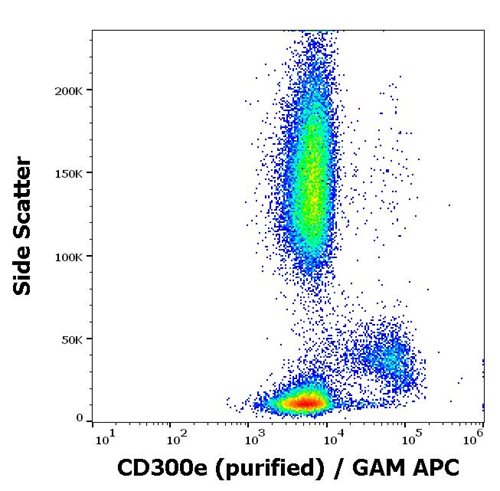Monoclonal Antibody to human CD163(Discontinued)
Shipping Info:
For estimated delivery dates, please contact us at [email protected]
| Amount : | 500 µg |
| Isotype : | Mouse IgG1 |
| Content : | 0.5 mg 0.2 µm filtered antibody solution in PBS, containing 0.02% sodium azide and 0.1% bovine serum albumin. |
| Storage condition : | Product should be stored at 4°C. Under recommended storage conditions, product is stable for one year. |
The monoclonal antibody RM3/1 recognizes CD163, a 130 kDa type I membrane glycoprotein, which is expressed exclusively in the monocyte/macrophage system. CD163 is a member of the cysteine-rich scavenger receptor superfamily. CD163 is an acute phase regulated receptor for the hemoglobin-haptoglobin complex. Another important function of CD163 seems to be in the adhesion of monocytes to activated endothelial cells. The expression levels of CD163 vary during the course of macrophage differentiation. The highest levels are found on tissue macrophages whereas bone marrow-derived cells are CD163 negative. CD163 positive cells include skin histiocytes, gut, Kupffer cells, and macrophages in spleen, thymus placenta and inflamed or tumorous tissues. The protein expression is markedly induced by glucocorticoids, IL-6 and IL-10 while down-regulated by cyclosporin A and by phorbol esters. CD163 can be cleaved to release to soluble form (sCD163). PMA can induce the shedding of sCD163. Intravenous lipopolysaccharide (LPS) produces a rapid rise of sCD163 in plasma of patient as it induces metalloproteinase-mediated shedding from monocytes surface. sCD163 in plasma is a parameter in diseases affecting macrophage function and monocyte/macrophage load in the body. The concentration of sCD163 is probably reflecting the number of macrophages of the 'alternative macrophage activation' phenotype with a high CD163 expression playing a major role in dampening the inflammatory response and scavenging components of damaged cells. As such sCD163 can be important as a disease marker in inflammatory conditions e.g. infection, autoimmune disease, transplantation, atherosclerosis and cancer. The monoclonal antibody RM3/1 can be used for macrophage phenotyping..The RM3/1 antigen expression is restricted to human monocytes and macrophages that evolve in the late phase of inflammation, predominantly macrophages of healing tissue. For macrophages in the synovialis of patients with rheumatoid arthritis; in alveolar macrophages and in Kupffer cells a double staining can be observed with the monoclonal antibody 25F9 recognizing- mature macrophages, which is not the case in other tissues.
FACS Analysis: Permeabilization as well as no permeabilization is used. Block cells with 1% BSA for 30';at 4°;C Functional Stusies: Reduction of CD69 expression by adding 2.5 µg/ml RM3/1 to 5x105 human T-lymfocytes in presence of exogenous CD163 Immuno Fluoroscence: Transfected CHO-cells were plated on coverslips and fixed in 4% paraformaldehyde for 2';. Cells were stained with 4 µg/ml RM3/1 for 60'. Immuno Precipitation: 10 µg RM3/1 was covalently coupled to beads (with 20 mM dimethyl pimelimidate), blocked with 0.2 M glycine buffer for 2 hr and incubated with cell lysate for 2 hr . Western Blot : SDS-PAGE under non-denatured condition. Block blot with 1% skimmed milk for 1h and incubate with RM3/1 (0.4 µg/ml) in 0.1%BSA/TBS for 1h. Detection of ~130 kDa product in spleens extracted in presence of NP-40 or in glucocorticoid-treated human monocytes. For immunohistology, flow cytometry and Western blotting dilutions to be used depend on detection system applied. It is recommended that users test the reagent and determine their own optimal dilutions. The typical starting working dilution is 1:10. CD163 is sensitive to ionic detergents and to chloroform/methanol treatment.
For Research Use Only. Not for use in diagnostic/therapeutics procedures.
| Subcellular location: | Cell membrane |
| Post transnational modification: | Phosphorylated. |
| Tissue Specificity: | Expressed in monocytes and mature macrophages such as Kupffer cells in the liver, red pulp macrophages in the spleen, cortical macrophages in the thymus, resident bone marrow macrophages and meningeal macrophages of the central nervous system. Expressed also in blood. Isoform 1 is the lowest abundant in the blood. Isoform 2 is the lowest abundant in the liver and the spleen. Isoform 3 is the predominant isoform detected in the blood. |
| BioGrid: | 114741. 2 interactions. |
|
There are currently no product reviews
|











.png)














